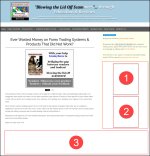- Home
- Trading Strategies
- 5 Forex Trading Strategies That Work
5 Forex Trading Strategies That Work
by Kuchar
(Australia)
As a beginner in the world of Forex trading, there are several things you must keep in mind to reap benefits off your investment. Initially, you must perform your due diligence, and choose a Forex broker trading platform that provides for three essential benefits –
1. The platform must be regulated, and trusted in the Forex market.
2. The platform must provide for a user-friendly experience.
3. The platform must provide for a strong blend of educational resources, which help you analyse possible trading opportunities, and provide access to quality research on the Forex market.
Excellent customer service and low operational fees and costs too, are essential when you choose a Forex broker trading platform. Once you have chosen a platform, open an account on it, deposit funds, and start buying and selling in currency pairs. The more knowledge you gain over time, the likelier you are to understand the market better, and make wiser trading decisions.
Beginners often feel stuck when foraying into the Forex market - in the quest of implementing the right strategies to garner maximum profits. Seasoned traders reap profits by implementing different Forex trading strategies. We have made the process of finding solid Forex trading strategies easier for you. Here are five Forex trading strategies that work.
1. Day Trading
day trading is a short-term Forex trading strategy that involves you holding your trade for a period of mere minutes, or even hours at a time. It is similar to swing trading, but at a frantic, faster pace. The timeframes in which you will trade are usually in bursts of 5, or 15 minutes. You goal is to capture the volatility of the day. You must conduct your trade on the most volatile session of your instrument – this is where the money is made.
As a day trader, you are likely to buy Support, sell Resistance, and trade Breakouts, Pullbacks and the Bounce of the Moving Average. The fundamentals of the economy and the long-term trend are irrelevant, and your goal is determine your bias for the day, and trade that very direction for the session.
2. Position Trading
Position trading is a longer-term Forex trading strategy that requires you to hold trades for weeks, or even months at a time. The timeframes in which you will trade are usually daily, or on a weekly basis. Position trading requires you to rely on fundamental analysis to give a bias on a stance you will make, as well as apply technical analysis (possibly) to better time the entries you have made, and stay ahead of others - or in other words enter the start of a new trend before others catch on.
For example, you analyse the fundamentals of a pair, and determine it to be bullish. Instead of going long at any place, you hold your position, and wait for the pair to come to Support. If your analysis is correct, there is a possibility that you could enter the start of a new trend altogether.
3. Scalping
Scalping is a Forex trading strategy that is very short term, constituting traders holding trades for minutes, or even seconds at a time. Scalping is not recommended for retail traders, as it involves a large transaction cost. Scalping also renders you slower than machines, putting you at a major disadvantage.
Nevertheless, as a scalper, your main concern is with respect to what the market is doing at that very moment of time, and how you can take advantage of it. Order flow is your main tool, and you must analyse the buy and sell orders in the market to make your decision/decisions.
4. Swing Trading
Swing trading is a medium-term Forex trading strategy that encompasses the process of holding trades for days, or even weeks at a time. The timeframes in which you will are usually on an hourly basis, or on a four-hour basis. Your main concern as a swing trader, is to capture a swing in the market.
You must learn concepts like Support and Resistance, Moving Average, and Candlestick Patterns. As a swing trader, you are likely to buy Support, sell Resistance, and trade Breakouts, Pullbacks and the Bounce of the Moving Average.
5. Transition Trading
Transition trading involves a sound understanding of Multiple Timeframes, and can lead to monster winnings. The idea of transition trading is to enter a trade on a lower timeframe and wait on the market. If the market goes on to move in your favour, you can trail your stop loss, or increase your target profit on a higher timeframe. Basically, you must find an entry on a lower timeframe, and plan your exit on a higher timeframe. A major plus point is that you can lower your risk, as your entry is on a lower timeframe.
Conclusion on the 5 best forex trading strategies
Forex trading involves years of experience, and sound knowledge of the market at large. Seasoned professionals do earn from the market, so do not expect to make it large, on your very first attempt. The strategies mentioned on this list have been used by several people – some earnings a lot, and others not so much (while some lose out altogether)! Nevertheless, Forex trading is an art, and an acquired taste. Perform your due diligence, strategize, analyse the market, and make investments on opportunities you deem fit.





